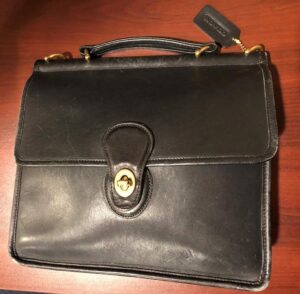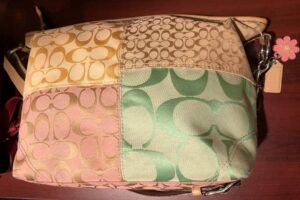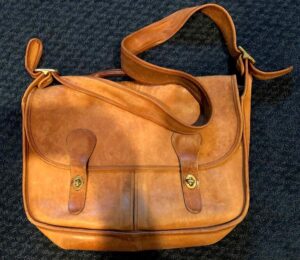
by Dr. Lori Verderame
What we now recognize as vintage Coach bags was founded as Manhattan Leather Bags in 1941. Founded by Lillian and Miles Cahn, the company founders were originally impressed by the design of a baseball glove. The baseball glove–what’s more American than that for an emerging company–inspired Cahn to create a handbag with similar characteristics. What did Cahn see in the baseball glove that he thought would transfer well to purses, handbags, briefcases, and pocketbooks? He liked the baseball glove’s stitching, tanned and supple leather. Cahn made his Coach handbags with the same high quality, supple leather and made sure to add strong and exact stitching.
The twelve (12) original handbag styles that Coach introduced initially in the 1940s were very well received with post-war American shoppers and fashion critics alike. While the original idea based on a baseball glove worked well in the early decades of Coach’s company growth, as time passed there was a need for new design innovations, new connections to the style of the day, and fresh ideas that kept up with the changing times of the mid-century modern era.
Coach Design
In 1964, Coach’s famous designer Bonnie Cashin came onto the scene. Cashin introduced leather, wool, and jersey into Coach handbags with good results. One of her biggest contributions to Coach style was the now iconic brass toggle hardware that was found on so many vintage Coach bags. Cashin had a motto that served Coach and its customers very well:
“Make things as lightweight as possible, as simple as possible, as punchy as possible, as inexpensive as possible.”
This attitude meant that Cashin’s debut collection came in classic, simple designs with fun colors like red brick, pastel pink, mustard yellow and grass green. The colors attracted modern shoppers who were decorating their homes with high design furniture like those designed by Eames, Bertoia, and Miller and integrating bright textiles by Marimekko and others. At Coach, they followed suit as madras cotton interiors became a trademark of Cashin’s designs. The Coach brand benefitted from Cashin’s insight and dedication to high style handbag features at an affordable price.
Coach in the 1980s
In 1979, Lew Frankfort joined the Coach company. Frankfort transformed Coach into a world-class brand in the 1980s. By the 1990s, Coach was considered an affordable luxury brand and its product lines were selling well nationwide.
Before Coach’s move into the broader handbag and purse market, handbags were one of two things: expensive high-end designer bags available to only a select few luxury shoppers or low-quality department store knock offs of high-end designer handbags. Under Frankfort’s direction, the Coach catalogue with photos of their latest styles emerged in the early 1980s and the company’s flagship store at 754 Madison Avenue in New York City opened to customers that would be loyal for decades to come.
While the early 1980s saw growth for Coach as an affordable luxury brand for the broad market, the mid 1980s was a time for change in the industry. The company was owned by Sara Lee and much needed capital was acquired. As the 1990s emerged, Coach had expanded to the profitable Asian market and was making, marketing, and selling watches and outerwear products like raincoats, too.
Coach in the 1990s
Like Bonnie Cashin, another Coach designer put his own stamp and personality onto Coach’s iconic products. Reed Krakoff took over designs at Coach in the early 1990s and moved the design of the lines away from Coach’s typical leather styles. The basic functional bags in tan, burgundy, black, and navy blue were quickly becoming a thing of the past. Krakoff favored new product lines featuring handbags in seasonal colors.
Accessories were also Krakoff’s responsibility including wristlets, wallets, and cell phone cases which sold well for Coach during the 1990s. Accessories of all types were part of the growing consumer and shopping culture of the late 20th Century. Not only did consumers want Coach handbags and briefcases but they wanted accessories to match. Some of the most common Coach accessories were leather pen/pencil cases, leather portfolios which included a business card pocket, pocket for important papers, and a handy interior pen loop. Computer disk cases by Coach held floppy computer disks. Leather day planners had refillable calendars. These new Coach accessories to satisfy the customers’ needs for matching, handy stuff.
Coach in a new Century
After Coach’s success in the 1990s, the company made a bold move to keep up with the other luxury brands in the early 2000s. In 2001, Coach launched its Signature collection which featured the newly introduced Coach logo. The Signature collection featured a bold double C, for Coach, logo design. At the turn of the 21st Century, everything—well every brand–had a logo and by the early 2000s, so did Coach. This move was a good one for Coach and the brand expanded into other markets and attracted new customers.
In 2006, the Legacy collection emerged using canvas, suede, and other materials; colors were brighter, and gone were the iconic brass toggle hardware in favor of magnetic closures and plated handbag hardware.
Select Coach Styles
Coach bags are immediately recognizable and some of the most popular styles have stood the test of time including:
The Coach Duffle is an iconic and stylish bag introduced in 1971. While it is a sturdy leather carry-all bag that can hold tons of stuff, the Coach Duffle is characterized by its informal slouch silhouette and oversized strap hardware allowing the consumer to shorten or lengthen the shoulder strap to their liking. Duffle bags by Coach are durable and look better over time as the leather ages.
Willis Station Bag is a classic bag and perfect for the commuter. The Willis Station Bag can be worn as a cross body and features the traditional traits of the Coach brand such as the toggle closure, a top leather handle, shoulder strap, and brass hardware with a strong style and interior and exterior pockets. Station bags, in general, were one of Coach’s most popular styles and continues the affordable luxury line for commuters.

Abbie Crossbody is a classic bag in various colors with a side pocket, shoulder strap, and zippered top opening. The design of the curved top has a playful architectural feel with a side pocket for sunglasses, checkbook or day planner.

The Coach Double C Patchwork Bag with logo has beige leather shoulder straps and an informal style which can hold everything you need while offering a bright –yellow, beige, pink, and green—group of colors and fun design. The patchwork features different colored sections each with the prominent Coach logo. A cute pink leather flower and Coach tag accessorize the bag hanging on a short metal chain that could be used as a keychain, too.

Court Bag is a popular briefcase/shoulder bag featuring Coach’s traditional brass toggle hardware, shoulder strap, leather handle, exterior side pocket for papers or a portfolio and tons of interior room for the busy professional. Designed with lawyers and business people in mind, the Court Bag is an organized catch all that meets the needs of working professionals.

Mussette Briefcase, introduced in the late 1980s, was introduced as a must have for graduate students, young professionals, and busy urban dwellers on the go. Two large front pockets that close with the famous Coach brass toggle closures, zippered interior pocket, exterior side pocket, chunky leather shoulder strap, and roomy interior all serve to make this briefcase a must-have bag.
Coach Accessories in the Vintage Market
Accessories also helped Coach achieve its status in the market with good looking leather items. On the vintage resale market, Coach accessories retain their value well and sell into the hundreds of dollars mark with ease including the leather pen case, portfolio with pad, computer disk case, day planner with paper calendar, traveling makeup case, small change purse with top clasp or small change purse with zipper, slim makeup case, dopp kit, credit card/business card case, wristlet wallet, expandable cell phone case, etc. Some of these accessories may need to be repurposed to keep up with technology’s changes like a cell phone case that was first introduced to accommodate bulky flip phones or a leather floppy disk case which now could be reused to keep track of phone chargers and computer battery cords and bricks.
Collecting and Reselling Vintage Coach Bags
Today, resellers look for vintage Coach bags and products and resell vintage handbags, purses, and accessories for top dollar online and elsewhere. The iconic styles of bygone decades have stood the test of time. On the vintage resale market for purses, handbags, and briefcases, the quality materials to which the Coach brand has remained dedicated make Coach items easy to resell. Coach items look good even decades after they were introduced.
Original sales tags as well as the leather Coach decorative tags found on many vintage pieces will impact value. Condition, of course, is always vital to selling leather purses on the resale market. If the condition is good, then the sales will be good too. It is the variety of styles, quality commitment of vintage Coach bags, and the widespread familiarity of the brand that make reselling vintage Coach products on the resale market a very good bet for any reseller.
Watch videos on my YouTube channel where I share more tips to valuing vintage coach bags. I can appraise your purses from photos or you can show me your purse during a video call.


